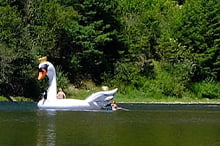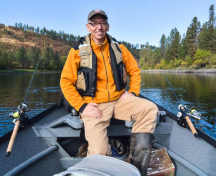No products in the cart.
Saint Joe and the Swan

Horror amid the Bridgestone Hatch
Story and Photos by John O’Bryan
The Saint Joe River, or the Joe, as it’s affectionately regarded, is a blue-ribbon freestone river (fed by snowmelt, not a spring) with aggressive westslope cutthroat trout that take the dry fly very well at certain times of the year. This beautiful course flows from Saint Joe Lake high in the Bitterroots, and then winds through miles and miles of Idaho before emptying into Chatcolet Lake on the south end of Lake Coeur d’Alene.
People from all over the country visit the river and during the fishable months, hundreds of drift boats are towed along St. Joe River Road to Marble Creek and then are floated down to the takeout at Calder.
The Joe has some of the best and most varied insect hatches in the region. Huge fish can be caught if you have the right fly and perfect timing. Many books and hatch charts have been written about this river, but one hatch is never mentioned that needs to be taken into consideration if you plan to fish the river in summer months.
When this particular hatch is happening, fish before the sun is warm or stay home and tie flies. The other option is to fish the wadeable water above Avery.
The Bridgestone hatch, as it’s called, should not be confused with a stonefly hatch. Don’t bother looking up the Bridgestone, I’ll explain it shortly. For now, you should know that just like a stonefly hatch, the Bridgestone hatch usually occurs in July and August. Aside from this, the two could not be more different, because the Bridgestone is a hatch to avoid.
This content is available for purchase. Please select from available options.
Register & Purchase Purchase Only
Register & Purchase Purchase Only


2 Responses to Saint Joe and the Swan
Bob -
at
Great story as always. I’m with you! Hate those tubes!
Peg Bowen -
at
John OBryan is such a creative storyteller. I thoroughly enjoy his articles in your magazine.